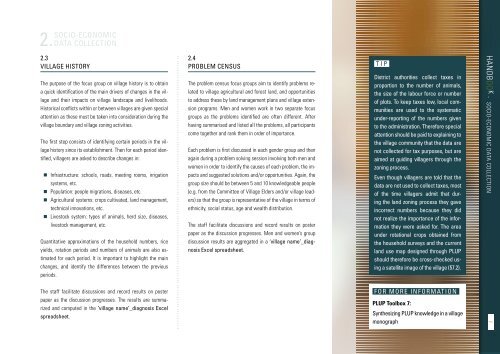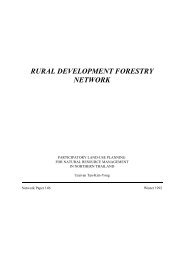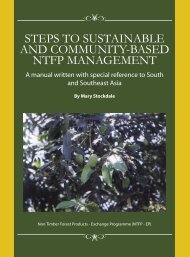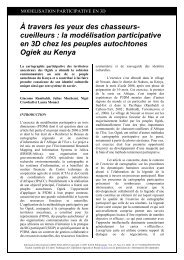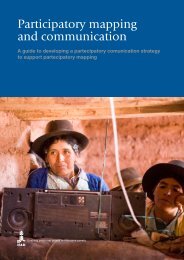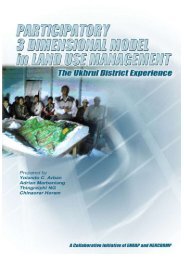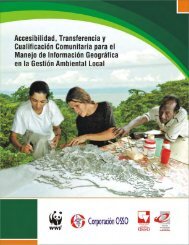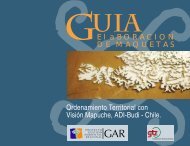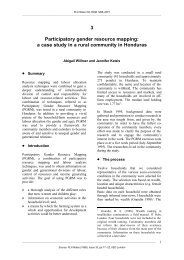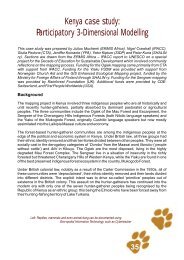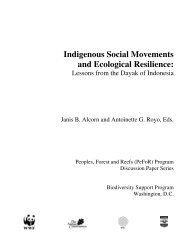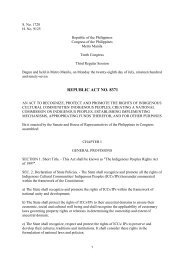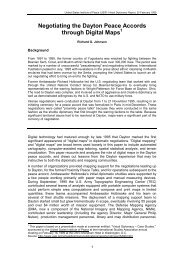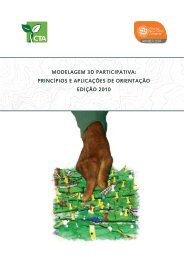Create successful ePaper yourself
Turn your PDF publications into a flip-book with our unique Google optimized e-Paper software.
2. Socio-economic<br />
data collection<br />
2.3<br />
Village history<br />
The purpose of the focus group on village history is to obtain<br />
a quick identification of the main drivers of changes in the village<br />
and their impacts on village landscape and livelihoods.<br />
Historical conflicts within or between villages are given special<br />
attention as these must be taken into consideration during the<br />
village boundary and village zoning activities.<br />
The first step consists of identifying certain periods in the village<br />
history since its establishment. Then for each period identified,<br />
villagers are asked to describe changes in:<br />
• Infrastructure: schools, roads, meeting rooms, irrigation<br />
systems, etc.<br />
• Population: people migrations, diseases, etc.<br />
• Agricultural systems: crops cultivated, land management,<br />
technical innovations, etc.<br />
• Livestock system: types of animals, herd size, diseases,<br />
livestock management, etc.<br />
Quantitative approximations of the household numbers, rice<br />
yields, rotation periods and numbers of animals are also estimated<br />
for each period. It is important to highlight the main<br />
changes, and identify the differences between the previous<br />
periods.<br />
2.4<br />
Problem census<br />
The problem census focus groups aim to identify problems related<br />
to village agricultural and forest land, and opportunities<br />
to address these by land management plans and village extension<br />
programs. Men and women work in two separate focus<br />
groups as the problems identified are often different. After<br />
having summarised and listed all the problems, all participants<br />
come together and rank them in order of importance.<br />
Each problem is first discussed in each gender group and then<br />
again during a problem solving session involving both men and<br />
women in order to identify the causes of each problem, the impacts<br />
and suggested solutions and/or opportunities. Again, the<br />
group size should be between 5 and 10 knowledgeable people<br />
(e.g. from the Committee of Village Elders and/or village leaders)<br />
so that the group is representative of the village in terms of<br />
ethnicity, social status, age and wealth distribution.<br />
The staff facilitate discussions and record results on poster<br />
paper as the discussion progresses. Men and women’s group<br />
discussion results are aggregated in a ‘village name’_diagnosis<br />
Excel spreadsheet.<br />
TIP<br />
District authorities collect taxes in<br />
proportion to the number of animals,<br />
the size of the labour force or number<br />
of plots. To keep taxes low, local communities<br />
are used to the systematic<br />
under-reporting of the numbers given<br />
to the administration. Therefore special<br />
attention should be paid to explaining to<br />
the village community that the data are<br />
not collected for tax purposes, but are<br />
aimed at guiding villagers through the<br />
zoning process.<br />
Even though villagers are told that the<br />
data are not used to collect taxes, most<br />
of the time villagers admit that during<br />
the land zoning process they gave<br />
incorrect numbers because they did<br />
not realize the importance of the information<br />
they were asked for. The area<br />
under rotational crops obtained from<br />
the household surveys and the current<br />
land use map designed through PLUP<br />
should therefore be cross-checked using<br />
a satellite image of the village (§7.2).<br />
HANDBOO K - Socio-economic data collection<br />
Participatory Land Use Planning (PLUP) HANDBOOK<br />
The staff facilitate discussions and record results on poster<br />
For more information<br />
paper as the discussion progresses. The results are summarized<br />
and computed in the ‘village name’_diagnosis Excel<br />
spreadsheet.<br />
PLUP Toolbox 7:<br />
Synthesizing PLUP knowledge in a village<br />
monograph<br />
7


